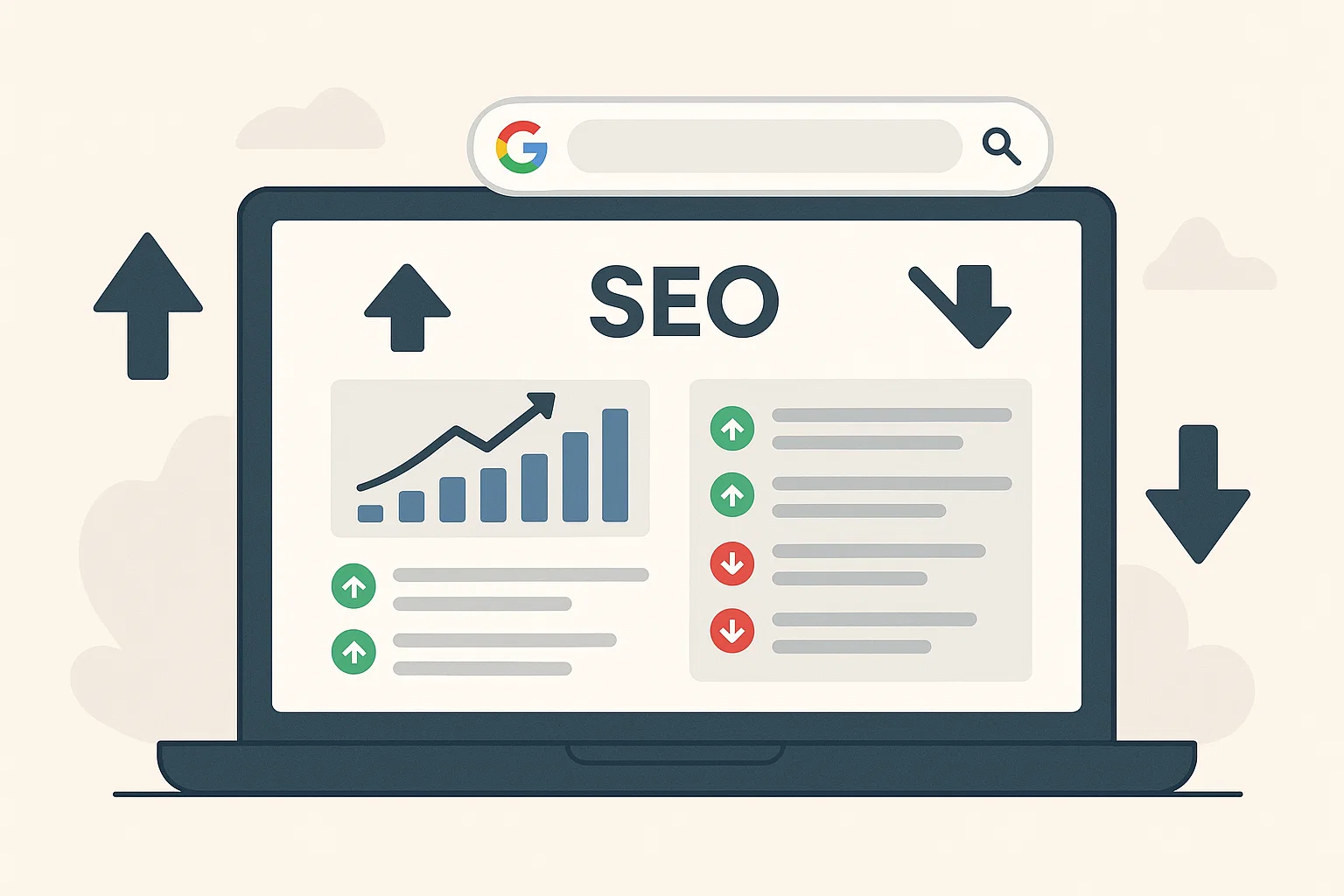
Let’s peel back the layers of what PageRank was, how Google updates work today, and why bloggers still search for that elusive “Google Page Rank update list.”
Why Google Page Rank Still Matters (Even If Hidden)
Picture this: it’s the early 2000s. Bloggers are obsessed with a little green bar called PageRank, Google’s way of showing you how important a page was, on a scale from 0 to 10. A PR7 site? Pure gold. A PR0? Basically invisible.
Larry Page (yep, the “Page” in PageRank) and Sergey Brin created it as a fancy way of saying: “If good websites link to you, you must also be good.”
Fast forward to today, Google stopped showing PageRank scores in 2016. But here’s the twist: they never actually stopped using it. They just tucked it away inside their algorithm.
So while we don’t see the numbers anymore, PageRank lives on behind the curtain, quietly shaping who shows up first when you type “best SEO tips” at 2 a.m.
Is Google Still Using PageRank?
The short answer: Yes, but not like before.
Then: PageRank was public. You could literally check your PR score with a browser tool.
Now: It’s hidden. Google has blended PageRank with hundreds of other ranking factors like speed, content quality, and mobile-friendliness.
Think of it this way, PageRank used to be a solo singer. Today, it’s part of the whole choir.
Even Googlers like Gary Illyes have admitted: PageRank (or at least its concept) is still in the mix. But instead of obsessing over a single number, SEO today is about trust signals, authority, and relevance.
How Often Does Google Change Rankings?
Here’s the reality check: Google tweaks rankings every single day.
Small changes happen constantly. You publish a blog, get a backlink, fix a typo, boom, your rank shifts.
Big updates (called Core Updates) happen a few times a year. That’s when people either celebrate or panic.
Imagine Google as a gardener. They’re always trimming, watering, and pulling weeds. But every few months, they redesign the entire garden. That’s a Core Update.
So, if your traffic graph looks like a rollercoaster, you’re not alone, it’s Google constantly fine-tuning the system.
Latest Google Algorithm Updates That Affected PageRank Signals
Even though the green bar is gone, many updates have built on the same foundation PageRank started: trust and quality. Here are the big ones:
Panda (2011): Went after thin, low-quality content. If your blog had 300 words of fluff, Panda ate it for breakfast.
Penguin (2012): Crushed spammy backlinks. Suddenly, buying 5,000 links for $5 wasn’t a winning strategy anymore.
Hummingbird (2013): Made Google understand context and intent, not just keywords.
BERT (2019): Helped Google grasp natural language better. Basically, it started “reading” like a human.
Helpful Content Update (2022+): Rewards content that genuinely helps users, not AI-generated fluff.
Core Web Vitals (2021): Ushered in speed, UX, and mobile-friendliness as ranking factors.
Each of these was like a mini “PageRank evolution.” Instead of counting just backlinks, Google now looks at how helpful, fast, and user-friendly your site really is.
How Often Is the Google Index Updated?
Back in the day, Google used to update its index monthly, what SEOs lovingly called the “Google Dance.” Websites would jump up and down the rankings like they’d had too much coffee.
Today? It’s way faster. Crawlers are constantly scanning and indexing new content. Sometimes your brand-new blog post ranks within minutes.
But don’t mistake speed for stability. Just because you show up quickly doesn’t mean you’ll stay there. Google’s index is a living, breathing thing.
Google Page Rank Update List – Expanded Timeline
| Year | Update/Event | What Changed | Impact on Rankings |
|---|---|---|---|
| 1998 | Birth of Google & PageRank | Larry Page & Sergey Brin launch Google using PageRank to measure importance by links. | Early webmasters scramble for backlinks. |
| 2000 | Google Toolbar PR | Public PageRank 0–10 scale introduced. | Link exchange mania begins. |
| 2003 | Florida Update | First major algorithm shake-up, killed keyword stuffing & spammy tactics. | Many affiliate marketers wiped out overnight. |
| 2005 | Nofollow Tag Introduced | Links with rel="nofollow" don’t pass PageRank. | Blog comment & forum spam loses power. |
| 2011 | Panda | Content farms, thin articles, and low-quality pages penalised. | Quality content becomes SEO king. |
| 2012 | Penguin | Cracked down on manipulative link-building (paid links, spammy anchors). | Many sites lost rankings overnight. |
| 2013 | Hummingbird | Focus on natural language & intent over raw keywords. | Conversational queries start ranking better. |
| 2014 | HTTPS as a Ranking Signal | Secure websites get a ranking boost. | Site migrations to HTTPS skyrocket. |
| 2015 | Mobilegeddon | Mobile-friendly design becomes a must. | Non-responsive sites vanish from top results. |
| 2015 | RankBrain | Machine learning added to interpret queries. | Smarter handling of synonyms & complex searches. |
| 2016 | Last Toolbar PageRank Update | Google stops updating public PR scores. | SEOs shift to DA/DR metrics instead. |
| 2018 | Medic Core Update | Shook up YMYL (Your Money Your Life) sites, health, finance, etc. | Authority & trustworthiness became vital. |
| 2019 | BERT | Better understanding of context & nuance in language. | Blogs using natural writing style benefit. |
| 2020 | Passage Indexing | Google starts ranking individual passages, not just whole pages. | Long-form blogs gain more visibility. |
| 2021 | Core Web Vitals | Speed, interactivity, and visual stability become ranking factors. | UX joins content & links as a top priority. |
| 2022 | Helpful Content Update | Focus on people-first content, not AI fluff or SEO tricks. | Sites with thin/duplicate content drop. |
| 2023 | Link Spam Update | Improved AI detection of unnatural link patterns. | Guest post farms & PBNs hit hard. |
| 2024 | AI & SGE (Search Generative Experience) | AI-generated overviews start showing in Google. | Pushes SEOs to focus on brand & authority. |
| 2025 | Continuous Core Updates | Google shifts to rolling updates instead of sudden drops. | Rankings change smoothly, but unpredictably. |
The official “update lists” you see online? They’re basically chronicles of how Google slowly buried the old PageRank while creating a smarter, multi-layered system.
How to Track “Page Rank” Without Google Showing It
Since Google doesn’t hand out scores anymore, SEOs rely on third-party tools that act like PageRank’s distant cousins:
Moz Domain Authority (DA): A 0–100 score predicting how well a site might rank.
Ahrefs Domain Rating (DR): Focuses heavily on backlink quality.
SEMrush Authority Score: A mix of traffic, links, and trust signals.
They’re not perfect, but they’re as close as we can get to the invisible PageRank system.
Tips to Improve Your “Page Rank” in 2025
Want to move up Google’s invisible ladder? Forget chasing a green bar and focus on what actually works today:
Earn quality backlinks. Not 10,000 junk links. One good mention in a trusted blog beats them all.
Create helpful content. If someone lands on your page and leaves happy, Google notices.
Optimise for speed. Slow sites get punished. Use caching, image compression, and lazy loading.
Make it mobile-friendly. Over half of Google traffic is mobile.
Stay fresh. Update old posts, add new insights, and keep things relevant.
Think of it less as “ranking hacks” and more as “building a site people (and Google) can trust.”
PageRank as Your Online Reputation
Here’s a fun analogy:
PageRank is like your reputation at a party. If cool people introduce you, others assume you’re cool too. But if shady characters are the only ones saying your name, people get suspicious.
Google works the same way. It’s basically asking: “Who’s vouching for this site, and are they trustworthy?”
So instead of chasing ghosts of PageRank past, treat SEO as reputation management. Build relationships, create good stuff, and the “votes” will follow.
Forget the Numbers, Focus on Trust
At the end of the day, the Google Page Rank update list isn’t really about scores anymore, it’s about signals. Trust. Authority. Relevance.
The secret? Consistency. Google doesn’t reward one-hit wonders. It rewards websites that keep showing up with helpful, reliable content.
So if you’re chasing that magical PageRank list, stop. Instead, chase trust. Chase quality. Chase creativity. That’s how you’ll rise.

Mia Creatives explores the intersection of technology and creativity. Dive into WordPress, SEO, and innovative ways to thrive online.